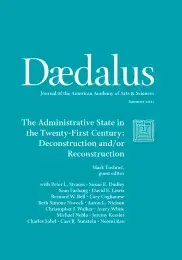Legislative Capacity & Administrative Power Under Divided Polarization
Conventional wisdom holds that party polarization leads to legislative gridlock, which in turn disables congressional oversight of agencies and thus erodes their constitutional legitimacy and democratic accountability. At the root of this argument is an empirical claim that higher levels of polarization materially reduce legislative productivity as measured by the number of laws passed or the number of issues on the legislative agenda addressed by those laws, both of which are negatively associated with party polarization. By focusing on the content of statutes passed rather than their number, this essay shows that in the era of party polarization and divided government, Congress has actually 1) enacted an ever growing volume of significant regulatory policy (packaged into fewer laws); 2) increasingly employed implementation designs intended to limit bureaucratic and presidential power; and 3) legislated regulatory policy substance in greater detail (reducing bureaucratic discretion) when relying on litigation and courts as a supplement or alternative to bureaucracy. This essay thereby complicates, both empirically and normatively, the relationship between Congress and administrative power in the era of party polarization and divided government.
Political scientists and scholars in cognate disciplines have in recent years devoted a great deal of attention to the issue of political polarization: polarization of political parties, other elites, and the public; and polarization’s causes and consequences.1 As to political parties, this literature on polarization has identified two main dimensions. The Democratic and Republican Parties have grown more distant from one another, and each has become more ideologically homogenous and cohesive.2 This is a signature feature of contemporary American politics and governance.
A clear consensus has emerged about Congress: party polarization contributes to “stalemate,” “gridlock,” “incapacity,” and “disfunction.” Compromise is necessary for a bill to navigate Congress’s many veto gates: committees, bicameralism, the Senate filibuster, and a two-thirds vote in both chambers in the event of a presidential veto. As the parties become more distant from one another and more ideologically homogenous and internally cohesive, there is less common ground in their legislative agendas, less opportunity for compromise, and more incentive to work for the opposition’s failure. In an institutionally fragmented Congress, the result of polarization is paralysis.3
The story of contemporary party polarization has a critical wrinkle. The legislative paralysis account is theoretically clearest in the context of divided government. If a more homogenous and cohesive party controls both chambers of Congress and the presidency–no matter how ideologically distant from the opposition–Congress may be more productive, not less, if the controlling party has a sufficient margin of seats to enact statutes without support from the opposition. Under divided government, however, cross-party negotiation and compromise becomes necessary. The threat of legislative paralysis is most clearly present under the combination of divided government and polarization.4
This combination is, of course, characteristic of our time. The most widely used measure of party polarization is the difference between the mean scores of Democratic and Republican members of Congress on the DW-NOMINATE ideology scale, which is based on roll call votes.5 This distance has been steadily increasing since about 1970 and, by 2020, it reached the highest level of the past century. The frequency of divided government has grown with polarization. From 1900 to the election of Richard Nixon in 1968, we had divided government only 20 percent of the time. From Nixon through Trump’s first term, it was divided 69 percent of the time. The estimated probability of divided government heading into the 2020 election was 78 percent, the highest in the past century. Figure 1 shows polarization (DW-NOMINATE averaged across the House and Senate; dotted line) and the estimated probability of divided government over the last century. I will refer to the era from about 1970 to the present as one of “divided polarization.”
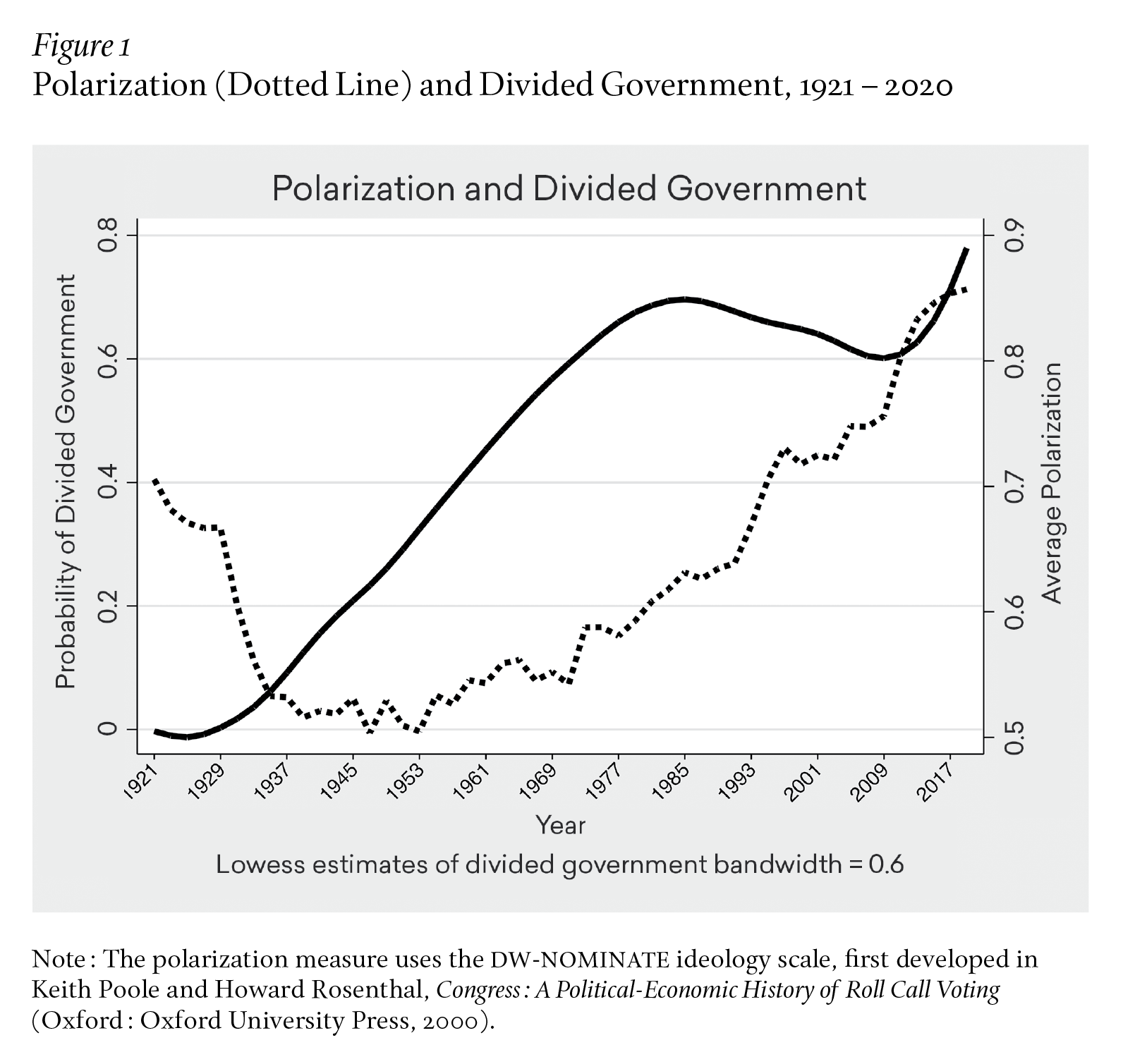
What have been the implications of divided polarization for administrative power? Probably the most common answer is that it enlarges administrative power. Under a system of separation of powers and checks and balances, Congress, the president, and federal courts supervise the administrative state and maintain its fidelity to law and accountability to the electorate. But according to the conventional wisdom just discussed, under divided polarization, Congress is disabled by legislative gridlock, stalemate, and incapacity. Legislative oversight of bureaucracy is a casualty. This widens agencies’ (and presidents’) policy-making berth and increases the range of actions they can take without fear of legislative reprisal.6
The normative implications of congressional incapacity are, not surprisingly, generally regarded as unhappy ones. As political scientists Michael Barber and Nolan McCarty note: “Perhaps one of the most important long-term consequences of the decline in legislative capacity caused by polarization is that Congress’s power is declining relative to the other branches of government.”7 The American administrative state’s legitimacy hinges on meaningful congressional oversight to ensure agencies’ democratic accountability. “A perpetually gridlocked Congress,” according to administrative law scholar Cynthia Farina, would produce “imbalance in control and accountability . . . rais[ing] hard questions about the constitutionality, as well as the wisdom, of an increasingly president-centered regulatory state.”8 Scholars have identified other potential implications of polarization for bureaucracy, but here I focus only on the relationship between divided polarization, congressional capacity to legislate, and administrative power.9
The notion that divided polarization induces legislative gridlock, which disables congressional oversight of bureaucracy, is quite plausible. It is in some tension with–though does not necessarily contradict–research in political science suggesting that divided government in the postwar United States is not clearly associated with lower levels of legislative productivity, and is associated with strategic moves by legislators facing ideologically distant presidents to craft the substance of legislation and design its implementation structures to achieve legislative goals in the face of executive opposition. Further insights about the influence of divided polarization on legislative capacity, and thereby on administrative power, may be gained by examining the substance and design of legislation, not just the number of statutes passed.
Empirically speaking, legislative productivity is generally measured by political scientists as a function of the number of statutes passed per Congress in combination with some measure of the laws’ significance.10 The body of laws identified in political scientist David Mayhew’s landmark study of divided government in the postwar United States has been especially influential and extensively studied in scholarship on congressional behavior. Mayhew’s key finding was that, contrary to widely held expectations, divided government was not associated with the number of significant laws passed per Congress. Some later work confirmed this result, and some contradicted it using different methods or measures.11 It seems fair to conclude from this body of work that we cannot confidently characterize Congress as less productive under divided government.
McCarty evaluates the relationship between party polarization and the number of significant laws passed per Congress and finds a negative association: more polarized Congresses are less productive.12 Congress scholar Sarah Binder finds that, among issues on the legislative agenda, more polarized Congresses resolve fewer of them by legislation.13 Such work is the principal empirical evidence cited for the proposition that more polarized Congresses are less productive.
In the area of civil regulation, I find the relationship between legislative productivity and our era of divided polarization to be more complex. The longitudinal picture presented below is based on statutes passed from 1947 to 2008 that were identified by Mayhew as significant and that contained any regulatory commands, defined as any mandatory proscription of actions that the legislation seeks to prevent or any mandatory requirement that the regulated population engage in specified conduct.14 This conception of civil regulation includes such policy areas as civil rights, consumer protection, environmental, labor, intellectual property, banking, antitrust, and securities regulation.
The upper-left quadrant of Figure 2 shows polarization (dotted line) alongside the number of significant regulatory statutes passed per Congress. After around 1970, as polarization grew, significant legislative enactments of regulatory laws declined materially. This is consistent with the empirical findings of McCarty and Binder, and the conventional wisdom that polarization in an era of divided government begets legislative gridlock and inaction. Passed legislation is one important and reasonable measure of legislative productivity, but others warrant consideration as well. I look at three measures that focus on the content rather than the number of laws.
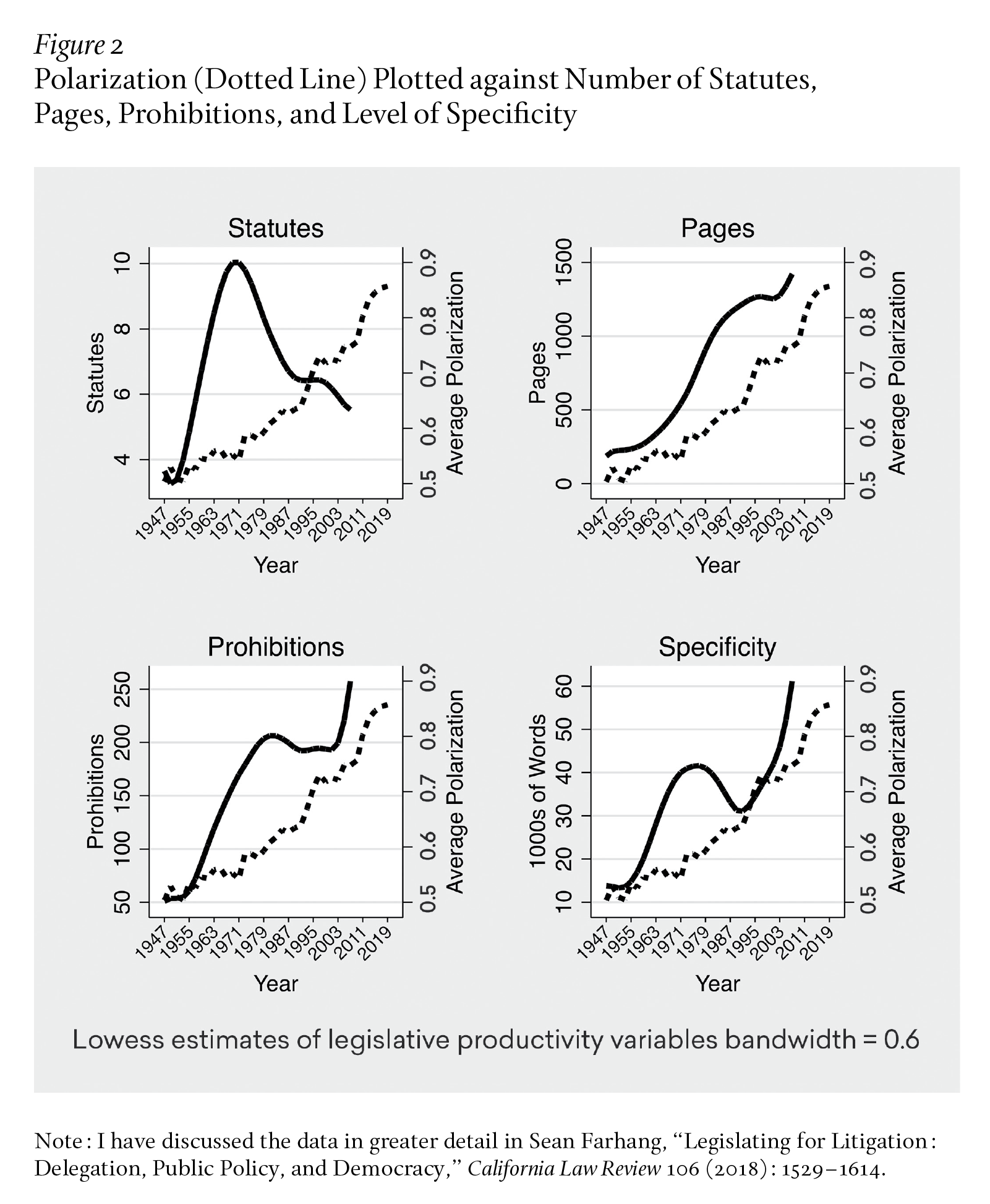
The first is crude but suggestive. The upper-right quadrant of Figure 2 shows the estimated number of pages (in the Statutes at Large) in the significant regulatory laws enacted per Congress. By this measure, legislative productivity has grown consistently, moving upward in striking tandem with polarization. It is natural to wonder, though, what content is actually contained in those pages. Perhaps polarization’s effect on the legislative process generates longer bills without correspondingly greater regulatory substance.
A second approach to legislative content focuses on actual regulatory commands issued by Congress. In the larger project from which the data are drawn, coders read each law and counted each separate regulatory command, producing a variable measuring the sum of discrete requirements and prohibitions imposed on regulated entities.15 The estimated number of such regulatory commands enacted in each Congress is shown in the bottom-left quadrant of Figure 2. By this measure, we again see long-run growth in productivity in parallel with growing polarization.
A third approach focuses on the degree of specificity of regulatory content. In the larger project from which the data are drawn, coders read each law and created a word count measuring the degree of specificity of the regulatory commands.16 The specificity variable is constructed as a word count with respect to only the portions of each statute that lay out the substantive regulatory policy specifying what conduct is prohibited or mandated.17 An illustration: The Fair Labor Standards Act Amendments of 1949 include a regulatory command that employees be paid overtime in an amount not less than one-and-one-half times their “regular rate.” This command occupies only six lines of the statute. Immediately following it, Congress provided an elaborate definition of “regular rate,” as well as extensive exemptions to coverage. The definition and exemptions occupied an additional 144 lines.18 The specificity measure registers important differences between a spare command and one with extensive elaboration. Congress resolved more policy substance with the command, definition, and exemptions (150 lines) than it would have with the command alone (six lines). The estimated total volume of words captured by this specificity measure in each Congress is pictured in the bottom-right quadrant of Figure 2. By this measure, we again see long-run growth in productivity in parallel with growing polarization.
How does this growth relate to administrative power? Congress may regulate without agencies by empowering litigants and courts rather than agencies as the implementation vehicle for regulatory commands (discussed below). However, Congress in fact relied primarily on agencies to implement the growing volume of regulatory policy. When coders identified each separate regulatory command, they also identified whether agencies were delegated authority to make substantive rules, impose sanctions, or hold administrative adjudications to implement the command.19 At least one of these three forms of regulatory power governed 88 percent of the regulatory commands. Figure 3 depicts party polarization (dotted line) alongside the estimated number of regulatory commands enacted per Congress that were governed by any of the three forms of administrative power, and separately displays the estimated number governed by substantive rulemaking, administrative sanctions, and administrative adjudications. When all three types were aggregated, administrative power to implement the regulatory commands grew steeply; the same is true with respect to rulemaking and administrative sanctions. The exception is administrative adjudications, which grew steeply starting in the mid-1950s, peaked around 1980, and declined thereafter.
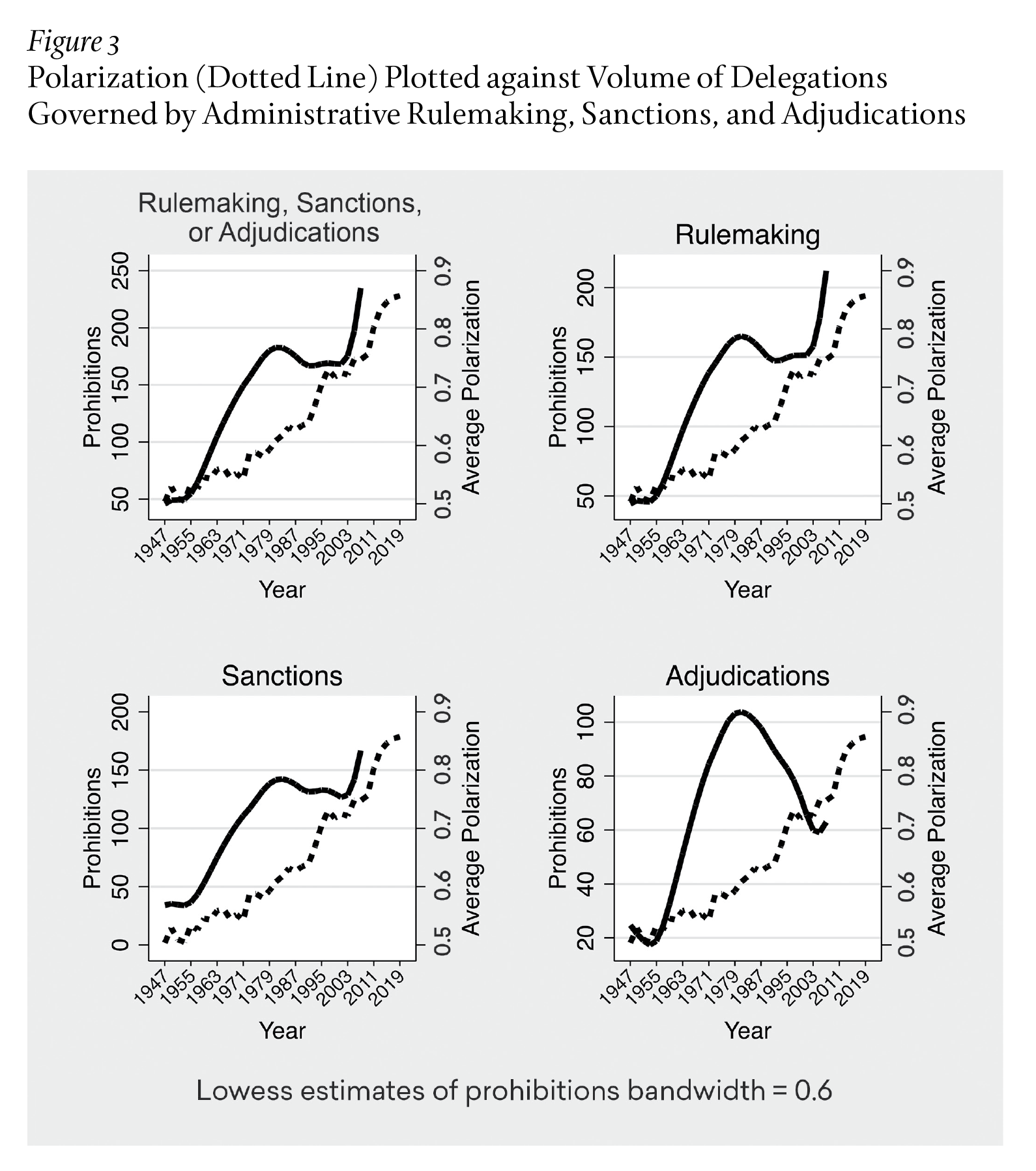
From 1969 to 2008, the estimated number of significant regulatory commands enacted per Congress grew from 159 to 258, and the number of words specifying substantive regulatory policy and the total number of pages grew by even wider margins. Along with the number of significant statutes passed, the volume of substantive regulatory law is another (partial) measure of legislative capacity in the domain of regulation. From about 1970 through 2008, during which time polarization increased consistently, Congress passed an increasing volume of regulatory commands that it entrusted to agencies for implementation.
Legislative productivity is a complicated concept. These data suggest that, over time, Congress packed more substantive regulatory policy into fewer statutes. It was less productive in some ways, and more productive in others. The literature on the effect of polarization on legislative productivity and oversight, and by direct extension the effect of polarization on administrative power, would be served by a more systematic theoretical and empirical grasp of the meaning of these multiple dimensions of legislative productivity.
Understanding how divided polarization has shaped administrative power requires that we consider the character of delegations to agencies as well as their number. Congressional oversight of agencies can take many forms. A large political science literature emphasizes that one form is for Congress to anticipate the threat of executive subversion prior to passage and diminish the need for active post-enactment oversight by resolving more substantive policy issues in the statute, and by including in the statute procedural rules intended to constrain presidential influence, limit bureaucratic discretion, and stack the deck in favor of the enacting coalition.20 If divided government in general is associated with greater antagonism between Congress and the president, and this affects how Congress fashions administrative power, then growing polarization will heighten that antagonism and the corresponding effects.
Political scientists John Huber and Charles Shipan, studying state legislatures, found that divided government leads to more detailed laws, with detail measured by a law’s word count.21 Facing an opposing executive, the legislature has greater incentives to nail down policy in more detail in the statute, increasing the chances that its preferences will be implemented. Political scientists David Epstein and Sharyn O’Halloran found that divided government leads Congress to delegate less discretion to the bureaucracy, with lower degrees of discretion measured by higher levels of formal structural constraints on administrative action, such as time limits for taking actions, reporting and consultation requirements, and limits on the amount of money that can be allocated to an activity.22 Political scientist David Lewis finds that when creating new agencies under divided government, Congress is more likely to structurally insulate the agency from presidential influence through mechanisms such as imposing qualifications on who the president can appoint, fixing the duration of their service, and placing agencies at a greater remove from presidential control (for instance, outside the cabinet).23 Together, this literature demonstrates that divergence of legislative and executive preferences–a hallmark of divided polarization–is associated with delegations to bureaucracy that are characterized by increasing levels of constraint placed on the exercise of administrative power.
A related and recently growing literature focuses on how Congress can constrain bureaucracy by fragmenting implementation.24 The literature has identified at least three dimensions of fragmentation. First, more fragmented policy implementation designs rely upon a larger number of distinct actors and entities to carry the law into effect, such as boards, commissions, secretaries, separate administrative officers, judges, and litigants. Second, power can be fragmented by dividing it over multiple distinctive sources of institutional authority, each of which has a significant measure of autonomy and independence, such as by distributing implementation power across separate administrative agencies. Third, power can be fragmented by empowering multiple actors and/or agencies to perform the same functions with respect to the same statutory provisions, creating overlapping jurisdictions.25 Drawing these threads together, a design is highly fragmented if it relies upon many actors and numerous agencies, and contains frequent episodes of overlapping jurisdiction.
Under divided polarization, fragmentation of an implementation framework can serve the legislative goal of constraining executive influence on implementers to subvert the preferences of the enacting coalition. This is, in part, because increasing the number of actors and agencies that must be coordinated to accomplish decisive action can, on balance, make significant departures from the policy status quo more difficult. It creates coordination challenges and a system of checks and balances that will limit presidential influence on implementation of the policy in question.26
Political scientist Miranda Yaver and I tested this theory with the significant regulatory legislation data discussed in the last section. In his classic work on American bureaucracy, James Q. Wilson characterizes American policy implementation as a “barroom brawl” with “many participants” and “no referee.”27 Yaver and I developed a measure of fragmentation in policy implementation to measure the extent of that brawl. The measure is a composite index based upon the number of 1) each discrete named actor/entity in each law that was empowered to execute the core regulatory functions; 2) different federal agencies delegated some authority to implement a core regulatory function in the law; and 3) instances that multiple administrative or judicial actors were simultaneously given the authority to perform the same regulatory implementation function in order to implement the same provisions of a law. Figure 4 shows the estimated values of our fragmentation index, measured in each law, over time. Over the long run, fragmentation grew steeply alongside polarization. We found in empirical models with controls that divided party government is clearly associated with fragmentation in policy implementation.28
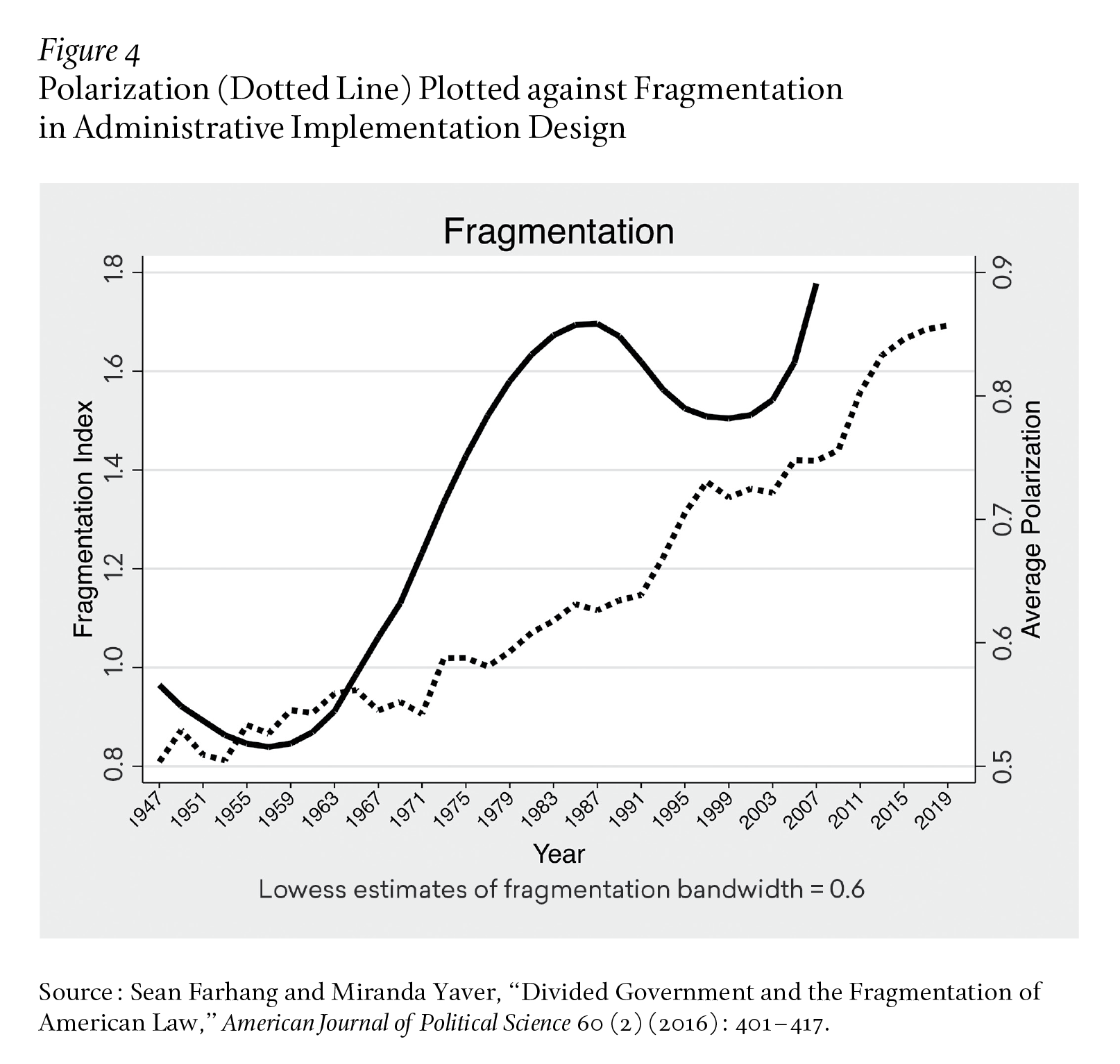
In the era of divided polarization, as Congress has produced an increasing volume of regulatory law and assigned it to agencies for implementation, the corresponding administrative power to carry the law into effect has been more encumbered by constraints on bureaucratic power and has been increasingly fragmented. Bureaucracy scholars disagree about the actual policy effects of these developments.29 The net policy effects of extensive constraints on and fragmentation of administrative power are difficult to assess (probably intractably so), and I do not engage that question here.
Whatever the policy effects, this empirical work on constraints and fragmentation in the era of divided polarization is in tension with the notion that congressional incapacitation by polarization has freed administrative power from the reins of legislative influence. Constraints and fragmentation are legislative means to control administrative power. They increase under conditions of legislative-executive conflict, a key feature of the era of divided polarization. Fragmentation is a strategy of legislative control of bureaucracy that grew at the same time that the number of enacted significant statutes declined. Like measures of the volume of regulatory substance discussed above, the temporal patterns of constraints and fragmentation underscore how grasping legislative influence on bureaucracy (or its absence) in our era of divided polarization can be furthered by evaluating the content of legislation as well as the number of statutes passed.
In our era of divided polarization, when the congressional majority faces an ideologically distant president, it also increases incentives for Congress to leverage private lawsuits to enforce its regulatory commands in court. Congress can do so by including express private rights of action in statutes and by incentivizing suits with statutory provision for attorney fee awards and economic damages for winning plaintiffs. When Congress distrusts bureaucracy because of a distant president’s influence, this correspondingly makes alternative or supplementary means of implementing statutory mandates more attractive. Private lawsuits are the chief alterative or supplement to bureaucracy for enforcing statutory mandates. Presidents have far less influence on private litigants and institutionally independent federal courts than on the bureaucracy. Private enforcement is thus a form of insurance against the president’s failure to use the bureaucracy to carry out Congress’s will.30
Since the late 1960s, in the era of divided polarization, private enforcement has become an increasingly significant facet of the American regulatory state, and Congress has increasingly taken recourse to this form of insurance.31 Turning again to the significant regulatory legislation data, Figure 5 reflects the estimated number of regulatory commands governed by a private right of action over time.32 Over the long run, it grew steeply alongside polarization. By the last three Congresses available in the data (2003–2008), 30 percent of the commands were governed by a private right of action. As with enactment of constraints and the fragmentation of implementation, divided government and Congress’s ideological distance from the president were powerfully associated with increasing congressional reliance on private enforcement.33
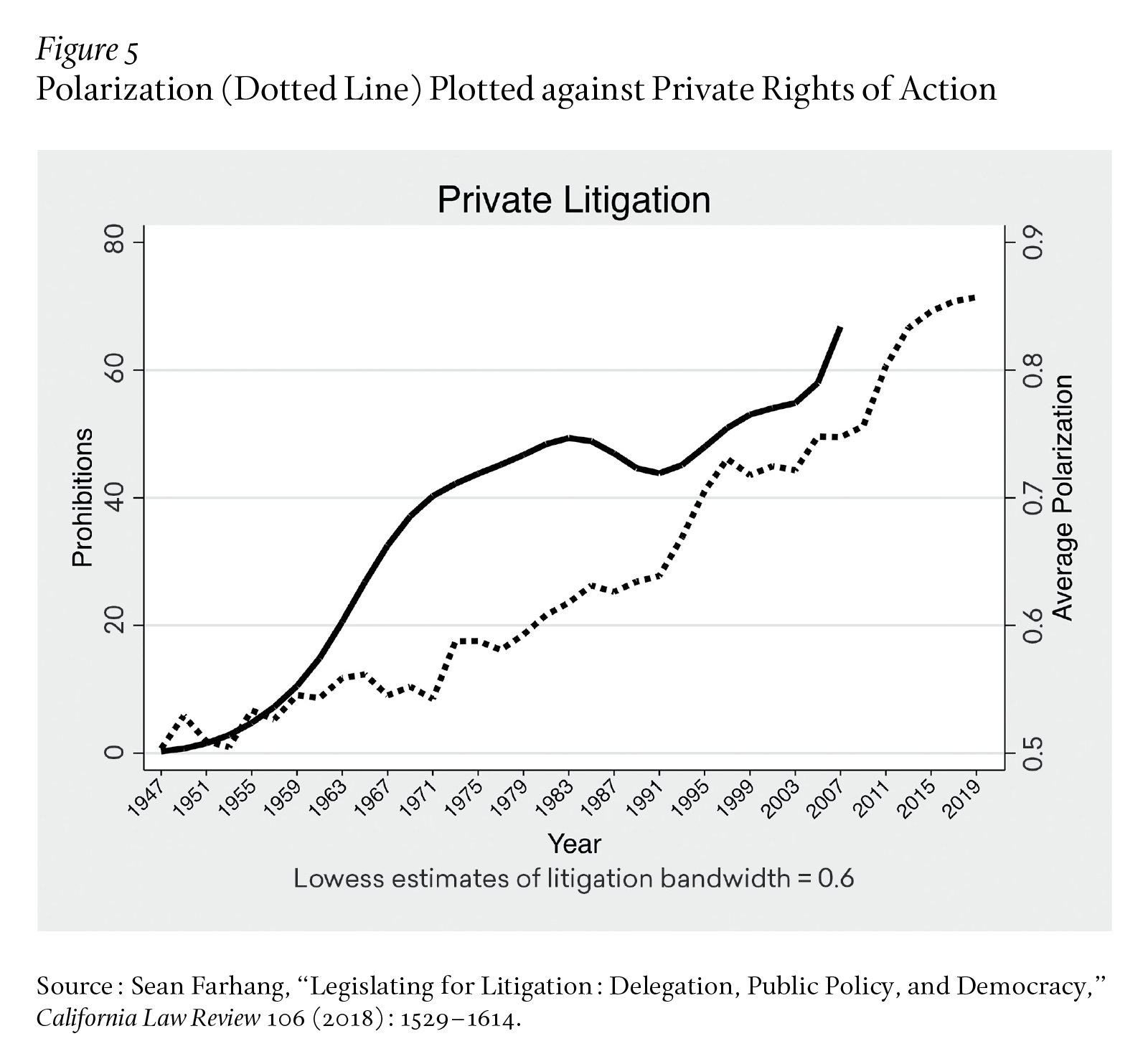
I referred to private lawsuits as an alternative or supplement to bureaucracy. As a descriptive empirical matter, Congress has overwhelmingly deployed private enforcement as a supplement (rather than as an alternative) to administrative power. When Congress has used a private right of action to enforce some regulatory commands, 87 percent of the time it simultaneously included administrative rulemaking, administrative adjudication, and/or administrative sanctions to implement the same commands.34 Growing legislative provision for private lawsuits in federal policy implementation does not correspond to a diminution in formally delegated administrative power, but rather changes the context and environment in which that power is wielded. When one focuses on legislative agendas rather than passed legislation, the last decade presents an interesting shift in partisan taste for private lawsuits to implement legislation. It has long been conventional wisdom in American politics and law that Democrats are far more likely than Republicans to favor access to courts to enforce individual rights with lawsuits. In collaborative work, legal scholar Stephen Burbank and I show that this conventional wisdom, long true, no longer reflects party agendas in Congress. We report the results of an empirical examination of bills containing private rights of action with pro-plaintiff fee-shifting provisions that were introduced in Congress from 1989 through 2018. The last eight years of our data document escalating Republican Party support for proposals to create individual rights enforceable by private lawsuits, mobilized with attorney’s fee awards. By 2015–2018, there was rough parity in levels of support for such bills by Democratic and Republican members of Congress.35
This transformation was driven substantially by growing Republican support for private enforcement in bills that were anti-abortion, -immigrant, and -taxes, and pro-gun and -religion. We demonstrate that this surge in Republican support for private lawsuits to implement rights was led by the increasingly conservative wing of the Republican Party, fueled in part by an apparent belief during the Obama years that the president could not be relied upon to implement their anti-abortion, -immigrant, and -taxes, and pro-gun and -religion agendas. We conclude that the contemporary Republican Party’s position on civil lawsuits has become bifurcated, reflecting the distinctive preferences of core elements of their coalition. They are the party far more likely to oppose private enforcement when deployed to enforce business regulation, while embracing it when deployed in the service of rights for their social conservative base.36
The relationship between agency powers and private enforcement is complex. As noted, in the significant regulatory legislation data, 87 percent of the time that Congress deploys a private right of action with respect to some commands, they are also governed by at least one of the fundamental forms of administrative power: rulemaking, adjudication, or sanctioning authority. When the private suits are adequately incentivized, the volume of litigation in some policy domains can become a dominant part of the policy landscape, dwarfing agency enforcement activity by comparison. In the past decade, there were about 1.7 million lawsuits in federal courts filed by private parties to enforce federal statutes, spanning areas such as antitrust, banking, voting rights, employment discrimination, police brutality, labor, environmental, consumer protection, intellectual property, and securities regulation, among many others.37
The effect of private suits on agency power in hybrid regimes is contextual and depends on the agency’s preferences and agenda. It is useful to distinguish between administrative power to create or elaborate legal rules and power to enforce legal rules. Under private enforcement regimes, agencies share enforcement powers with private plaintiffs and their attorneys. From the standpoint of an agency seeking to control or limit enforcement (for example, under more deregulatory leadership), private enforcement can diminish agency power. Agency actions to withdraw or diminish enforcement pressure will be less consequential, or even inconsequential, if private enforcement readily picks up any slack left in the wake of agency inaction.38 This weakens the hand of deregulatory or antiregulatory presidents or agency leadership. On the other hand, private enforcement may advance an agency agenda of robust enforcement when the agency lacks the resources or political capacity to execute it directly.39 Thus, on the enforcement dimension, private enforcement’s influence on agency power is asymmetric. It is more likely to weaken agencies with a deregulatory and antiregulatory stance and to strengthen those with a more activist regulatory stance.
Shifting the focus from rule enforcement to rule creation and elaboration, the increasing role of private lawsuits intermingled with administrative power in the era of divided polarization leads bureaucracy to share more of the lawmaking field with courts. Even in the absence of private rights of action, courts will participate in elaborating statutory meaning under judicial review of agency actions. However, private enforcement regimes make litigation and courts part of the frontline implementation infrastructure, and often make courts interpreters of first instance as opposed to reviewers of agency interpretations. This can exponentially multiply courts’ role in elaborating statutory meaning. Each of the 1.7 million private lawsuits filed in the past decade to enforce federal statutes was an opportunity for federal courts to interpret the federal statutes in question.
Recent research has identified an additional implication of growing private enforcement for administrative power. Legislative coalitions, which include policy experts and sophisticated interest groups, recognize potential problems associated with tilting the balance of power toward greater statutory elaboration by courts. One is that federal judges have far less policy expertise than agencies. Another is that, post-enactment, life-tenured and institutionally independent federal judges are far harder for Congress to influence than bureaucrats. That is, postenactment oversight, short of passing new legislation, is far more difficult with respect to courts. As a result, there are strong theoretical grounds to expect that when Congress relies upon private enforcement, it will resolve more regulatory policy substance in Congress and delegate less lawmaking power to implementers.40 In an empirical analysis of the significant regulatory legislation data, I find this to be the case. With extensive control variables in the models, I find that when relying on private enforcement, Congress devotes much more attention and effort to developing policy substance in hearings on the bill and specifies substantive regulatory policy in substantially more detail.41
Increasing legislative reliance on private enforcement as a strategy to effectuate congressional commands in the era of divided polarization and the corresponding elevation of Congress’s role in making substantive regulatory policy are in tension with the notion that congressional incapacitation by polarization has freed administrative power from the reigns of legislative influence. The rise of private enforcement under divided polarization was a strategic legislative choice to supplement or (sometimes) evade administrative power. By determining policy substance in more detail in statutes with private enforcement regimes, a large majority of which included administrative implementation powers as well, Congress left administrators less power to go their own way. Further, this regulatory strategy grew at the same time that the number of enacted significant regulatory statutes declined. Like measures of the volume of regulatory substance in statutes and temporal patterns of constraints upon and fragmentation of administrative power, these results highlight that the study of legislative influence on bureaucracy (or its absence) can be advanced by evaluating the content as well as the number of statutes passed.
A repeated claim in the literature on polarization is that legislative paralysis so damages congressional oversight of the administrative state as to seriously threaten its constitutional legitimacy and democratic accountability. This contention rests, in part, on empirical findings about a negative relationship between party polarization and congressional productivity, generally based on longitudinal empirical studies of the number of laws passed by postwar Congresses or the number of issues on the legislative agenda addressed by such laws. This work is persuasive and important, but it paints an incomplete picture. By focusing on the content of the laws passed, this essay shows that in the era of divided polarization, Congress has actually enacted an ever-growing volume of significant regulatory policy–packaged into fewer laws–increasingly employed implementation designs intended to limit bureaucratic and presidential subversion of legislative preferences, and legislated regulatory policy substance in greater detail when relying on litigation and courts as a supplement or alternative to bureaucracy.
© 2021 by the American Academy of Arts & Sciences. Published under a CC BY-NC 4.0 license.
